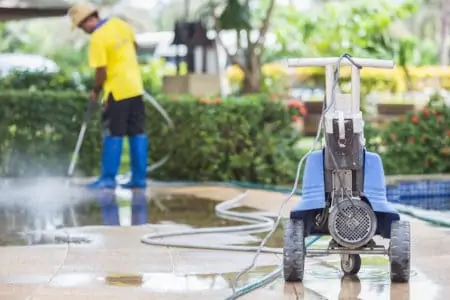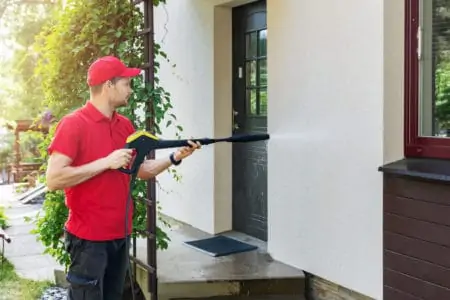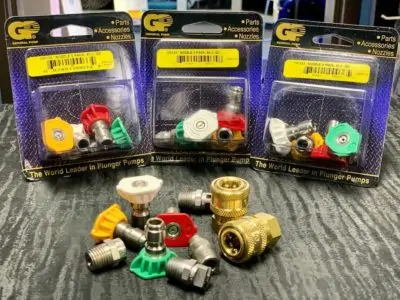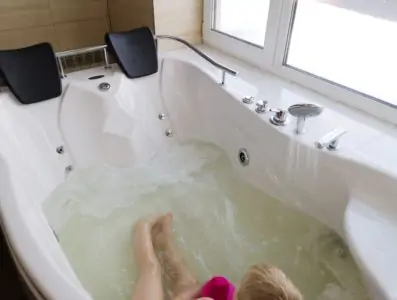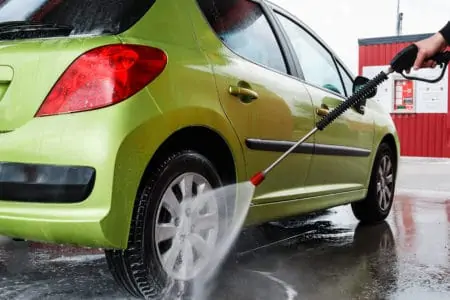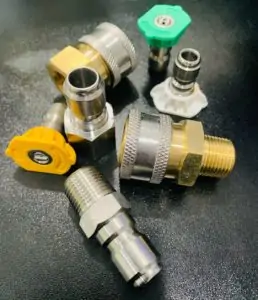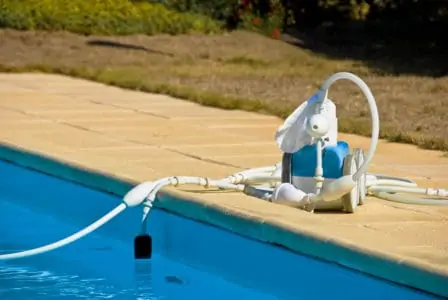Are you throwing a pool party, looking to take a relaxing evening dip, or just practicing your strokes? Then you need to make sure your pool is clean.
Pool maintenance is one of the prices you pay when you install a pool in your yard, but with the right tools, it’s worth it.
We’ll walk you through how to clean pool tiles with a pressure washer. Then we’ll show you a technique and method that will speed this task up and give you sparkling results.
Key Takeaways
- Use a pressure washer between 1200 and 2600 PSI to clean pool tiles safely and effectively.
- Wear protective clothing and ensure pool area is clear before starting the cleaning process.
- Start with low pressure and gradually increase it while working in small sections to prevent tile damage.
- Follow safety precautions such as keeping a safe distance, using the right nozzles, and keeping the pressure washer moving.
Is It Safe to Clean Pool Tiles with a Pressure Washer?
Yes, as long as you take the right precautions.
Firstly, you’ll need to use the right type of nozzle and PSI to make sure that you clean the tiles without causing any damage.
You should also make sure that you are taking personal safety precautions. This includes wearing protective clothing and keeping your hands out of the way of the water stream.
If you’re using a heated pressure washer or power washer, you must also be aware of the heat.
You should also check in with your user manual to make sure the pressure washer is safe to use for and around pools. Especially with electric pressure washers since there may be a risk of electrocution.
Lastly, make sure all the connections inside your pool are secure so you don’t damage any of these intricate parts.
How to Clean Pool Tiles with Pressure Washer
Let’s get your pool tiles totally refreshed. We’ll walk through the necessary tools and the step-by-step instructions so you’re fully prepared.
What You Need
- A pressure washer preferably between 1200 and 2600 PSI. If you go above 2000, be sure to test in an inconspicuous spot and use a wide spray nozzle.
- Protective clothing and shoes.
- A variety of nozzles and attachments — a long spray gun is a handy tool.
Top Tip
Step by Step Instructions
- Put on your protective clothing.
- Set up your pressure washer first. If yours can reach high temperatures, choose hot water or steam. If not, that will be fine. It just might take a bit longer to clean.
- Clear the pool. Get rid of debris using a net or pool vacuum. Clean the surrounding area, too. Get rid of pool toys, too, as they can get in your way and reflect water at you which can cause injury.
- Test out the desired pressure. We recommend starting with low pressure or using the widest nozzle to clear out the initial debris and dirt. Sweep along the tiles in horizontal motions for about 30 seconds, or until the surface dirt is gone.
- Start cleaning in small sections, gradually building up the pressure or changing nozzles until you find the ideal cleaning power for you. Make sure each area is clean before moving onto the next section.
- When you get to tight spaces, corners are tough grout lines, change nozzles or attachments when necessary. A long spray gun will help you get into harder-to-reach places.
- Once you’re finished, turn off the pressure washer and disconnect the unit. Pull the trigger to release any pressure or leftover water. Let the area dry thoroughly, especially if you have pool tiles around the pool as this will now be a slipping hazard.
Tips for Pressure Washing Pool Tiles Safely
It’s important to practice safety above anything else when using a pressure washer. Here are our top tips for preventing tile damage and harm to yourself or others.
Figure Out the Right Pressure
You’ll find conflicting advice online about what pressure to use for cleaning pool tiles, but we recommend between 2000 and 2600.
If your pressure washer is around 3000 PSI, you should stand further back and use a wide spray nozzle. With any PSI, always test in an inconspicuous spot and use wide nozzles to ensure that you aren’t going to cause damage to your pool tiles.
Stand Three Feet Back
As mentioned, you should stand back from your tiles. Three feet is a good rule of thumb. If you stand too close and apply direct pressure, you risk cracking the tiles.
Send the Family Indoors
When pressure washing, make sure that no other family members or pets are in the vicinity. They could easily forget the task you’re doing and end up in harm’s way if they are playing or trying to speak to you.
Don’t Let the Wires Get Wet
This is especially true for electric pressure washers that are hooked up to an outlet. Don’t let them get wet. Water and electricity don’t mix. Check your user’s guide to see if it’s safe to use near a pool or for pool tiles.
Use the Right Nozzles
Test out your nozzles and use the right ones as recommended by the manufacturer. In our opinion, anything over 25 is ideal. The zero-degree nozzle is one you definitely want to avoid.
Keep the Pressure Washer Moving
While we recommend working in small sections before moving onto the next section, you should keep the pressure washer moving in that specific spot. If you keep the pressure washer in one spot for too long, you run the risk of cracking the tiles because of the repeated pressure.
FAQs
Clean Tiles in No Time
Pressure washing your pool tiles ticks this task of your to-do list in no time. It’s a lot faster than cleaning the tiles by hand, and a lot less stressful.
There are some safety precautions you need to take to make sure you’re doing this job properly without the risk of damage or injury.
Always make sure to wear protective clothing. Use the correct PSI and test in an inconspicuous spot. And be sure to never mix the electric wiring with the pool water.
Once you have familiarized yourself with the safety tips and read the instructions, you’ll be good to go!
